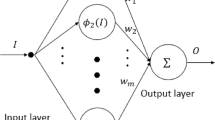Abstract
In this paper, a robust control scheme is proposed for a class of time-delay uncertain nonlinear systems with unknown input using the sliding mode observer. The sliding mode state observer is given with radial basis function neural networks, and then the robust control scheme is presented based on the designed sliding mode observer. The developed observer-based control scheme consists of two parts. One term is a linear controller and the other term is a neural network controller. Using the Lyapunov method, a criterion for bounded stability of the closed-loop system is developed in terms of linear matrix inequalities. Finally, a simulation example is used to illustrate the effectiveness of the proposed robust control scheme.



Similar content being viewed by others
Explore related subjects
Discover the latest articles and news from researchers in related subjects, suggested using machine learning.References
Ge SS, Hong F, Lee TH (2003) Adaptive neural network control of nonlinear systems with unknown time delays. IEEE Trans Autom Control 48(11):2004–2010
Hsiao FH, Hwang JD (1996) Stabilization of nonlinear singularly perturbed multiple time-delay systems by dither. J Dyn Syst Meas Control 18(1):176–181
Nguang SK (2000) Robust stabilization of a class of time-delay nonlinear systems. IEEE Trans Autom Control 45(4):756–762
Park JH (2004) On the design of observer-based controller of linear neutral delay-differential systems. Appl Math Comput 150:195–202
Mou C, Chang-sheng J, Qing-xian W (2008) Robust adaptive control of uncertain time delay systems with FLS. Int J Innov Comput Inf Control 4(8):1995–2004
Wang Z, Huang B, Unbehauen H, Robust H (2001) ∞observer design of linear time-delay systems with parametric uncertainty. Syst Control Lett 42:303–312
Raghavan S, Hedrick JK (1994) Observer design for a class of nonlinear systems. Int J Control 59(2):515–528
Xiong Y, Saif M (2001) Sliding mode observer for nonlinear uncertain systems. IEEE Trans Autom Control 46(12):2012–2017
Choi HH, Ro KS (2005) LMI-based sliding-mode observer design method. IEE Proc-Control Theory Appl 152(1):113–115
Koshkouei AJ, Zinober ASI (2002) Sliding mode observer for a class of nonlinear systems. In: Proceedings of the American control conference, Anchorage, AK May 8–10
Tan CP, Edwards C (2002) Sliding mode observers for detection and reconstruction of sensor faults. Automatica 38:1815–1821
Edwards C, Spurgeon SK, Patton RJ (2002) Sliding mode observers for fault detection and isolation. Automatica 36:541–553
Mou C, Chang-sheng J, Qing-xian W (2008) Sensor fault diagnosis for a class of uncertain time delay nonlinear system using neural network. Int J Autom Comput 5(4):401–405
Song B, Hedrick JK (1995) Observer-based dynamic surface control for a class of nonlinear systems: an lmi approach. IEEE Trans Autom Control 49(11):1995–2001
Wang C-H, Liu H-L, Lin T-C (2002) Direct adaptive fuzzy-neural control with state observer and supervisory controller for unknown nonlinear dynamical systems. IEEE Trans Fuzzy Syst 10(1):39–49
Liu C-C, Chen F-C (1993) Adaptive control of nonlinear continuous systems using neural networks general relative degree and MIMO cases. Int J Control 58(2):317–335
Noriega JR, Wang H (1998) A direct adaptive neural-network control for unknown nonlinear systems and its application. IEEE Trans Neural Netw 9(1):27–34
Xu H, Ioannou PA (2000) Robust adaptive control for a class of MIMO nonlinear systems with guaranteed. IEEE Trans Autom Control 48(5):728–742
Ge SS, Wang C (2004) Adaptive neural control of uncertain MIMO nonlinear systems. IEEE Trans Neural Netw 15(3):674–692
Mou C, Chen W-H (2010) Sliding mode controller design for a class of uncertain nonlinear system Based on disturbance observer. Int J Adapt Control Signal Process 24(1):51–64
Mou C, Jiang C, Bing J, Qing-xian W (2009) Design of sliding mode synchronization controller for uncertain chaotic systems with neural network. Chaos, Solitons Fractals 39(4):1856–1863
Acknowledgments
The work is partially supported by NUAA Research Funding (No. NS2010060) and Jiangsu Natural Science Foundation (Granted Number: SBK2008390). The authors also gratefully acknowledge the helpful comments and suggestions of the reviews, which have improved the presentation.
Author information
Authors and Affiliations
Corresponding author
Appendix
Appendix
1.1 Proof of Theorem 1
Proof Consider the Lyapunov function candidate
where \( V_{0} = e^{\text{T}} (t)Pe(t) + \frac{1}{2}\tilde{\theta }^{\text{T}} \Upgamma^{ - 1} \tilde{\theta } + \sum_{i = 1}^{n} {{\frac{1}{{\mu_{i} }}}} \tilde{W}_{i}^{\text{T}} \tilde{W}_{i} ,\,\,V_{1} = x^{\text{T}} (t)Rx(t),\,\,V_{2}=\beta_{1}\int_{t-\tau}^{t}x^{T}(s)x(s)\) and \( V_{3} = \beta_{2} \int_{t - \tau }^{t} {e^{\text{T}} (s)e(s)ds} \).
Considering (1), (10), (15) and (23), the time derivative V satisfies
Considering Lemma 1, it is clear that
Considering (27), (28), (29) and (30), we have
Substituting (19), (20) and the expression of v into (31) yield
It is clear that the following fact is held:
Thus, (32) can be rewritten as
According to Lemma 1, we obtain
where α i > 0, i = 1, 2, 3, 4.
Considering the following fact
and substituting (35)–(40) into (34) yield
Determining X = [x, x(t − τ)]T, E = [e, e(t − τ)]T, then (41) can be written as
where
From (24), we obtain
For (43), premultiplying and postmultiplying by diag{R, I}, we have M < 0. From (25), we obtain N < 0.
When \( {\frac{\delta }{2}}\left\| {\tilde{\theta }(t)} \right\|^{2} - X^{\text{T}} MX - E^{\text{T}} NE > \alpha_{1}^{ - 1} \eta + \alpha_{2}^{ - 1} \varepsilon^{*} + \alpha_{3}^{ - 1} \eta + \alpha_{4}^{ - 1} \varepsilon^{*} + {\frac{\delta }{2}}\left\| {\theta^{*} } \right\|^{2} \), from (42), we obtain
According to (42), the semi-global uniform ultimate boundedness of estimate error of the state observer and states of the closed-loop system are guaranteed. This concludes the proof.
Rights and permissions
About this article
Cite this article
Chen, M., Jiang, B., Jiang, Cs. et al. Robust control for a class of time-delay uncertain nonlinear systems based on sliding mode observer. Neural Comput & Applic 19, 945–951 (2010). https://doi.org/10.1007/s00521-010-0365-9
Received:
Accepted:
Published:
Issue Date:
DOI: https://doi.org/10.1007/s00521-010-0365-9




